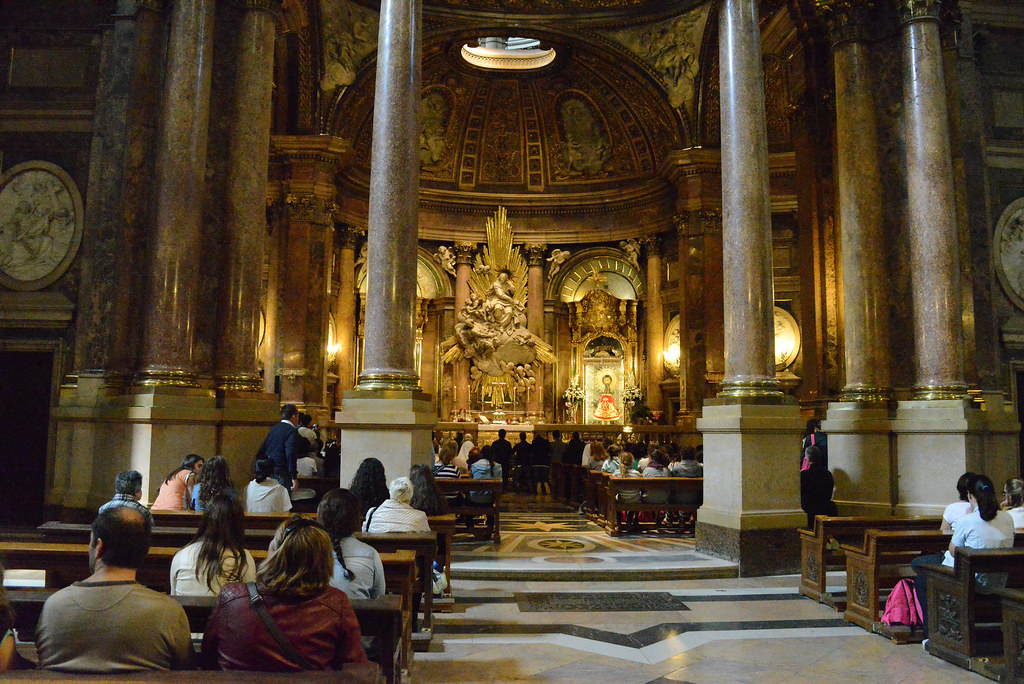


The first half of 2025 has brought unprecedented numbers of international pilgrims, with 2.64 million visitors recorded between January and June. Among them, 9,290 came in officially registered groups from 24 different countries—an increase of nearly one-third over last year.
(ZENIT News / Zaragoza, 08.13.2025).- Zaragoza’s Basilica of Our Lady of the Pillar, long cherished in Spain as both a national treasure and a site of profound Marian devotion, is now making headlines for another reason: its global reach. The first half of 2025 has brought unprecedented numbers of international pilgrims, with 2.64 million visitors recorded between January and June. Among them, 9,290 came in officially registered groups from 24 different countries—an increase of nearly one-third over last year. For the Metropolitan Chapter of Zaragoza, the figures confirm what many locals have sensed for months: the basilica’s plaza has never seemed so full of languages, flags, and accents from around the world. A New Geography of Devotion While Spain’s own faithful remain the backbone of daily worship, the real headline is the transformation of the basilica into a genuinely international pilgrimage hub. The United States now leads in numbers, sending 1,845 pilgrims this year, while the Philippines maintains a strong second place with a 28% increase. Mexico and Colombia have both posted significant growth, and Indonesia’s numbers have surged. Even more striking, China’s contingent has doubled, with 342 pilgrims making the journey.
Some of these arrivals are newcomers entirely: Uganda, Vietnam, Hong Kong, and Angola joined the roster for the first time in 2025, adding a vibrancy and diversity rarely seen before. “The Pillar is not just a Spanish devotion anymore—it belongs to the universal Church,” says Father Miguel, a canon of the basilica, standing at the edge of the nave as a group from Poland sings a Marian hymn in their own language. “When people arrive here, they’re stepping into centuries of history, but also into a living, global community of faith.”Christian books A Shrine in Context The Basilica of the Pillar occupies a unique place among Catholic pilgrimage sites. Unlike Lourdes or Fatima, which are associated with 19th- and 20th-century apparitions, the devotion here traces its roots to the earliest days of Christianity. Tradition holds that the Virgin Mary appeared to the Apostle James in Zaragoza around 40 A.D., standing on a pillar of jasper that is still venerated today.
This deep historical pedigree gives the basilica an allure that is at once ancient and enduring. “It’s a different kind of pilgrimage,” explains Maria Santos, a guide who has worked at both Lourdes and Zaragoza. “Here, people are not coming for healing water or a miracle story—they’re coming to touch something that connects directly to the apostles. That’s rare.” Why 2025 is Different May has always been a high-water mark for pilgrimages, but this year’s figures—over 3,950 international pilgrims—mark a nearly 40% increase from the same month in 2024. June followed with another dramatic jump. Only April saw a decline, likely due to calendar and climate factors. But beyond raw numbers, the tone of pilgrimages seems to be changing.
Organizers note that more groups are integrating cultural and historical tours into their itineraries, combining faith with a deeper exploration of Spain. For Zaragoza’s economy, this has meant fuller hotels, busier restaurants, and expanded tour offerings that weave together faith, art, and local gastronomy.Catholic church tours A Bridge Between Continents Comparisons to Lourdes in France or Fatima in Portugal are inevitable, but Zaragoza has a distinctive advantage: geography. Located between Madrid and Barcelona, it is easily accessible to travelers visiting Spain for broader tours. The city’s AVE high-speed train makes day trips possible from major hubs, while the basilica itself, with its riverside setting and baroque towers, offers a postcard-perfect focal point for devotional gatherings. “The Basilica of the Pillar is a meeting place of worlds,” says Dr. Elena Ruiz, a historian of Marian devotion at the University of Navarra. “Its story is ancient, its architecture magnificent, and its role today is both pastoral and cultural. That combination is rare—and very attractive to an international audience.”
With Jubilee Years on the horizon for other shrines and cities, competition for international Catholic pilgrims is intensifying. Yet Zaragoza’s 2025 performance suggests it is more than ready to hold its own.
Source: Zenit News
Read & Share This Catholic Patriotic Minute!
